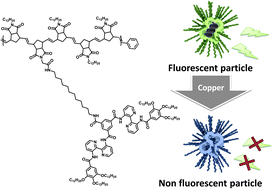The unique physical properties of supramolecular polymers resulted in a myriad of potential applications ranging from electronics to healthcare and high performance materials. The large spectrum of available self-assembling molecules allows the properties of supramolecular polymers to be tuned to specific requirements of the desired applications. It has been recently shown that linear polymers grafted with non-covalent (or dynamic covalent) interacting groups lead, under selected conditions, to the folding of single polymeric chains into what are now termed single chain polymeric nanoparticles (SCPNs). Due to the unique properties of SCPNs, these well-defined nanometer-sized objects are actively investigated for use in advanced applications in low viscosity coatings, catalytic systems and nanomedicine.
In this context, Palmans and co-workers envisionned chemosensing of metal ions as an interesting application of SCPNs. The authors prepared 3,3′-bis(acylamino)-2,2′-bipyridine substituted benzene-1,3,5-tricarboxamide (BiPy-BTA) grafted polynorbornene polymers. The polymers fold intramolecularly via p–p interactions into fluorescent, compartmentalised particles of nanometer-size. Spectroscopic and light scattering techniques show that the compact conformation of the folded polymer is affected by increasing the BiPy-BTA functionalisation degree and by changing the solvent polarity. Changes in the conformation are accompanied by changes in the fluorescence intensity. Due to the affinity of the BiPy units for metal ions such as copper, the particles obtained are effective sensors for these metals. The compartmentalisation of the binding motifs in SCPNs proves to be advantageous in sensor applications of these particles.
Single chain polymeric nanoparticles as compartmentalised sensors for metal ions by Martijn A. J. Gillissen, Ilja K. Voets, E. W. Meijer and Anja. R. A. Palmans, Polym. Chem., 2012, 3, 3166-3174.
To keep up-to-date with all the latest research, sign up for the journal’s e-alerts or RSS feeds or follow Polymer Chemistry on Twitter or Facebook.











